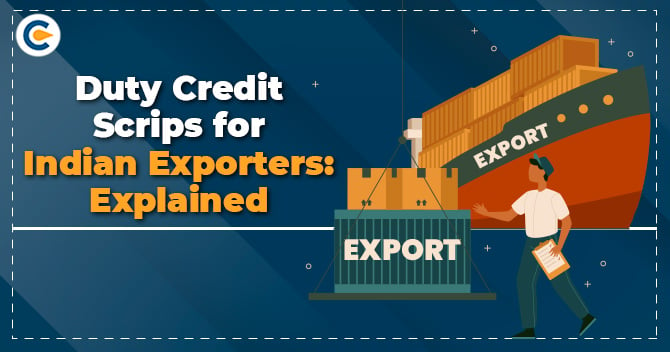Duty Credit Scrips refers to export promotion benefits mentioned under the Foreign Trade Policy (FTP) 2015-20. It aims to encourage exporters to boost the influx of overseas currency in India. Duty Credit Scrips facilitates tax incentives on exports, which aid exporters to set off their import related duties. It is granted under the schemes like) Service Exports from India Scheme (SEIS), Merchandise Exports from India Scheme (MEIS), and the Export Capital Goods Scheme.
FTP 2015-20 sets out the norms around Duty Credit Scrips in India. The scheme is launched and managed by the Ministry of Commerce and Industry and DGFT, i.e. Directorate General of Foreign Trade[1].
What purpose does Duty Credit Scrips serve in general?
- DCS can aid exporters to address tax liabilities. It can be used against active tax obligations arising out of mandatory custom duty, safeguard duty, transitional specific safeguard duty, & anti-dumping duty.
- Duty Credit Scrip is transferable but cannot be used to skip GST, compensation cess, and education cess.
- Duty Credit Scrip stays valid for 24 months from the date of issuance.
- DCS is transferrable, and it will continue to render the same services to the third party that was available to the first party.
- One can revalidate DCS by making a special request to DGFT under certain events.
Underlining the functionality aspects of Duty Credit Scrips
DCS aids the exporter to limit their exposure to tax liabilities and save cash to meet their export orders. Duty Credit Scrip of 2% to 5% is available to the exporters as per the EXIM Policy regulations.
Imagine a case where an exporter has secured an export order and needs to import raw material to kick start the production. Apparently, the exporters shall need funding to execute the production and dispatch undertakings. At this point, the exporter has no other option than to use working capital to address production and shipping requirements. This is where DCS comes into the picture. It allows the exporter to set off upfront liabilities without denting the working capital.
Duty Credit Scrips under various FTP schemes
Duty Credit Scrips is an exporter incentive instrument that is available under various schemes of FTP as shown below:
Under MIES
- Within 12 months from the date of let export order*.
- Within three months from the day, EDI bills are furnished to the DGFT portal by the Customs.
- Printing/release of non-EDI shipment bills, whichever is later.
- The application filing can be done via Ayat Niryat Form 3A, along with shipment bills and eBRC.
- Under MEIS, a DCS is facilitated upon the realization of FBO valuation of exports in foreign exchange @ 2-5 per cent, based on the product imported.
The Let Export Order*aka LEO is the final step in the compliance checklist for exporting goods out of India.
Under SEIS
- In SEIS scrips, the due date of filing the application is 12 months from the closure of the FY of the claim period.
- Under SEIS, you will have to opt for the port of registration and add it to the application.
- The GOI shall grant incentives of 3-5 per cent to all the Service providers from Indian Territory to entities abroad.
- This scheme came to effect in 2015. The validity duration for this scheme has been capped at five years.
- Under SEIS, Duty Credit Scrip is granted for 5 per cent of the overall foreign exchange earned.
Under EPCG
Post Export EPCG Duty Credit Scrip Scheme
- Post-export, the EPCG DCS scheme is made is accessible to Indian exporters who want to import capital goods by paying the applicable duty via cash.
- Basic Custom Duty addressed on capital goods will be reverted via DCS, similar to those granted under Chapter 3 of Foreign Trade Policy.
- Specific EO will be 85 per cent of the applicable EO under the EPCG scheme. But, the average EO will remain unchanged.
- Duty remission will be in accordance with the EO fulfilled.
- Norms for using scrips granted under Chapter 3 of FTP will also cover post export EPCG DCS.
- All provisions of the existing EPCG Scheme shall apply insofar as they are not inconsistent with this scheme.
Documents to be shared with authority for obtaining DCS
- Copy relating to the foreign inward remittance certificate
- Copy of IEC code.
- CA certificate
- Copy of RCMC certificate, i.e. Registration cum membership certificate
- Copy relating to the invoice
- Copy of foreign exchange earned
- List of directors (in case of companies)
- Board resolution
In the DGFT’s notification released in 2019, the authority shared the decisions of phasing out hard copies of SEIS and MEIS DCS granted with Electronic Data Interchange port as the port of registration.
But, either scrip will continue to be transmitted digitally from DGFT to Customs. The particulars, such as assessment of Bill of Entry, registration of DCS, giving out of charge, etc., shall be accessible to the respective officers in ICES. As an exporter, you need to register the scrips with the Customs Authority. Customs House Agent shall render this registration for you.
How long does DCS remain valid?
From the issuance date, the Duty credit scrip remains valid for 24 months. But the benefits prevail even after the expiration of the validity period. DCS is transferrable, and hence it can be sold out by the exporter at any instance to any third party. Also, the exporter has the liberty to revalidate the same by filing a special request under specific circumstances.
Sale of Duty Credit Scrips
Duty Credit Scrips is a beneficial instrument that empowers exporters to address upfront shipping obligations easily. But, in case of no export, it does make sense to sell DCS before its validity gets exhausted. The Duty Credit Scrips can be sold out in the open market at a price depending on the term of use and validity period.
For example: if you have a DCS worth Rs. 2,00,000, which implies that it can be utilized to pay duties and taxes equivalent to Rs 2,00,000. Buying at a discounted price doesn’t hinder the face value of the scrip.
Key points to ponder
- The scrips holder primarily uses them to address the shipping liabilities that appear in the form of customs duty and applicable taxes. Scirps are transferrable and can be sold to any third party, including the importer in the business transaction.
- The facility of Duty Credit Scrips is available under several schemes launched under the FTP. The names and benefits under these schemes are subjected to changes that could occur from time to time.
- These scrips are granted by the DGFT’s regional office.
Conclusion
Exporting activities attract significant duties and taxes. This is where Duty Credit Scrip comes into the picture. It enables exporters to extinguish immediate liabilities such as customs duty and additional customs duty by solving their fiscal issues. Therefore, Duty Credit Scrip plays a vital role in the shipping business and serves as an asset for exporters.
Read our Article:How to Secure LMPC Certificate to Import Pre-packaged Goods in India?













